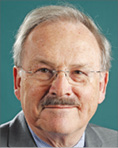
Patrick W. Serruys, Editor-in-Chief
I recently returned from the annual PCR London Valves meeting which this year was held in Berlin. As always, it was impressive to see this meeting consolidate its position as the premier meeting within the valvular interventional field. This year’s edition was no exception, with over 2,000 delegates attending. The choice of location was perhaps a little quirky, a little confusing. Gus Pichard told me that he landed in London and almost forgot to catch his transfer to Berlin as the PCR Valves meeting has become so synonymous with London. For others, it was sometimes strange to talk about “London” while we were in Berlin.
William Wijns, in his opening speech as chairman of PCR, took the opportunity of the temporary relocation to pay tribute to the German cardiologists who have put aortic valve interventions on the map. Together with the recent EEP publication in EuroIntervention1, many of our colleagues were fully aware of these impressive achievements.
Sunday was a very busy day, mainly focusing on technical aspects, which were of a very high quality; however, the opening case on Monday was the real highlight for me. Hussein Ince gave a fabulous demonstration of “MitraClipping”, working fully under imaging control, like a master tailor from London’s Savile Row. One could see perfectly the clip and the mitral valve in 2D and 3D while he was working perpendicular to the line of coaptation. The result of the first clip was spectacular; nevertheless, a small colourful flame of very limited regurgitation was evident and, with great composure and grace, he told us he needed to implant a second clip. Personally, I was worried, but Hussein knew exactly what he was doing and, after the second clip, no regurgitation was found. As he worked basically as a solo operator, the case went quickly. In fact, the panel had to fill the remaining time with what turned out to be a very enlightening discussion.
This case set the tone for the whole meeting. Immediately after, Maurice Enriquez-Sarano gave the keynote lecture entitled “Mitral regurgitation: a disease of the valve and myocardium. When and how should we intervene?”. Maurice was very convincing, demonstrating that in the future we will probably have to treat the anatomic disease before specific early functional signs of deterioration appear. In other words, we should not treat the patient only when the symptoms are evident but treat the disease before irreversible functional deterioration appears. This message is so important since in the past to submit an individual to the “surgical operative shock” was a major decision, whilst nowadays percutaneous treatment allows us to mimic the act of the surgeon without the aggression of opening the chest.
I do not wish to trivialise the percutaneous treatment of the aortic valve, but my perception was that in many talks the following three themes emerged repeatedly – low-risk, all-comers, and patients older than 60 years. Finally, we have to give credit to surgeons in the sense that all the creative treatments that they have applied to patient care are now mimicked by the treatment of the interventionalist, for example annuloplasty, duplicating the Alfieri technique, reducing the dimension of the left ventricle and the atrial cavity, and so on. These surgical skills are now becoming doable and feasible with percutaneous techniques and they facilitate early anatomic correction before the onset of functional deterioration. From that point of view, I found the meeting enlightening. I would be very surprised if progress were not readily made in the field of mitral interventions, despite the much more complex challenges in pathology.
Reference

